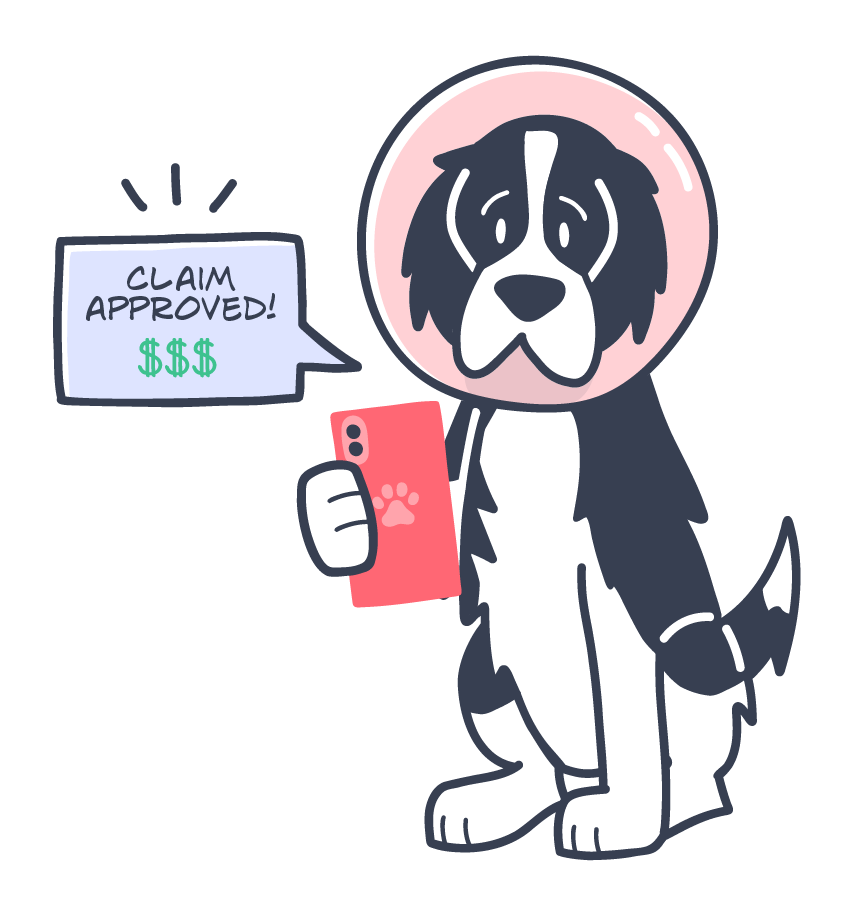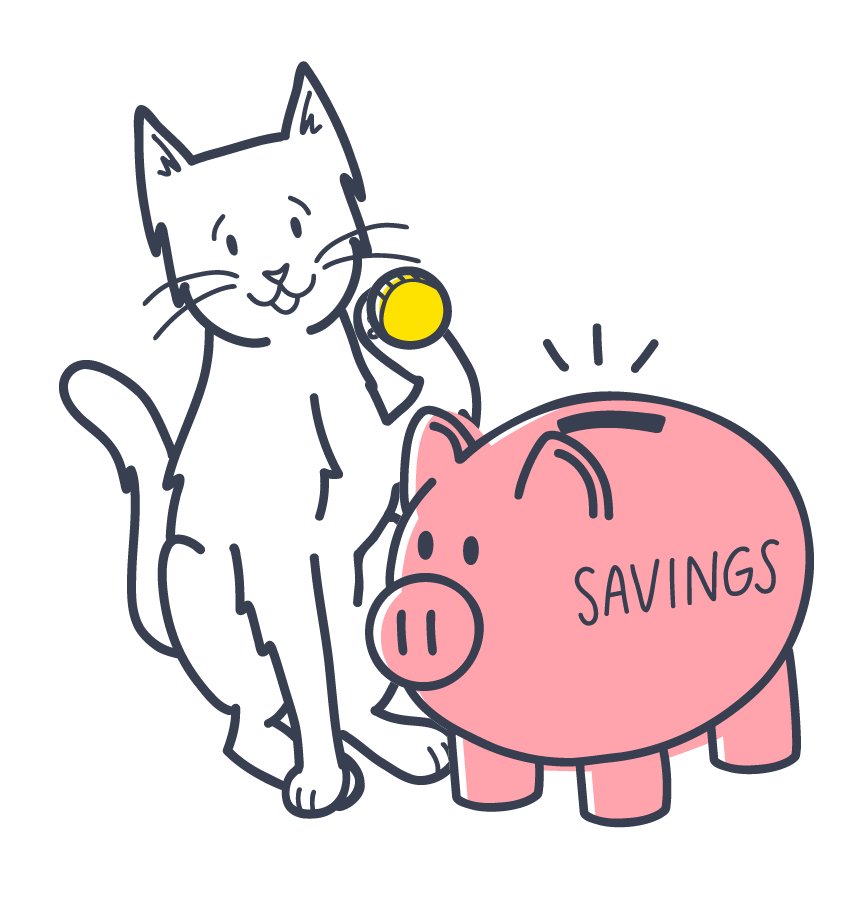When you’re considering which pet insurance plan is the best fit for you and your pet, you’ll want to know how much it will cost, and what it covers. The short answer to both of those questions is – it depends!
Pet insurance plan costs and coverage can vary depending on your plan type, pet’s age, breed, species, and location, so it pays to do your research to figure out which plan is the right one for you. Let’s dig into the costs of pet insurance, what factors can affect that cost, and what pet insurance can cover, so you have the info you need to find the right plan!
- How much does pet insurance cost?
- What affects the cost of pet insurance?
- Can I change the cost of my pet insurance plan?
- What do pet insurance plans cover?
- What doesn’t pet insurance cover? What are the exclusions?
- FAQS
How much does pet insurance cost?
It’s hard to get an average cost of pet insurance because plans are unique to each pet and the cost is calculated based on a variety of factors. The quickest and easiest way to see how much a pet insurance plan would cost for your pet is to fill out a quote online. You can get a free quote from Pumpkin in minutes!
Getting a quote online can show you the price there and then. Your quote will also be personalized to the plan preferences you’ve selected.
What affects the cost of pet insurance?
When you fill out a pet insurance quote online, you’ll see that there’s usually a monthly or annual premium price that you pay for your plan, and plan premiums may vary based on several factors. When you fill out a quote with info about your pet, a pet insurance provider will usually ask you:
- Do you have a dog or cat? The price of monthly premiums is different for the type of pet you have. Usually, dogs are more costly to insure than cats.
- What is your pet’s breed and size? The breed and size of your pet may affect your monthly premiums. Larger pets usually cost more to insure than smaller pets.
- How old is your pet? Premiums may be different for puppies and kittens compared to adult dogs and cats. This is because young pets tend to have fewer health problems. You will find that insuring senior pets tends to cost more, with some insurance plans limiting coverage for senior pets, or not offering it at all.
- Where are you located? Where you and your pet live may alter your premium. Pet insurance providers might ask for your state and ZIP code before they can calculate your plan cost.
Can I change the cost of my pet insurance plan?
There are usually several coverage options you can select when creating your pet insurance plan that may change your monthly premium. There are three main plan factors you may be able to change:
Reimbursement rate: This is the percentage your plan will reimburse you for covered vet bills. A higher reimbursement rate may increase your monthly premium.
Annual deductible: This is the amount you can choose to pay towards covered vet bills each year before your pet insurance reimbursements kick in. A higher annual deductible usually decreases your monthly premium.
Annual coverage limit: This is the maximum amount your pet insurance plan will reimburse you for eligible expenses every year. A higher annual coverage limit usually increases your monthly premium.
Let’s see how these factor into the cost of some hypothetical plans. Imagine you’re considering two different plans for the same pet from the same pet insurance provider:
Plan A: 80% reimbursement rate, $500 annual deductible, $10k annual limit
Plan B: 80% reimbursement rate, $250 annual deductible, $20k annual limit
Since they both have the same reimbursement rate, which one will likely cost more? Well, first Plan B has a lower annual deductible which means you will pay less towards covered vet bills before your reimbursements kick in. Second, Plan B has a higher annual coverage limit, which means there’s a larger amount of money available to cover your eligible veterinary expenses. Both these factors mean that the Plan B premium will likely cost more than Plan A.
Pet insurance costs can also differ in price based on whether you choose to pay your premiums monthly or annually (e.g. if a provider charges a transaction fee to pay monthly) or after pet insurance provider-specific discounts are applied, such as military discounts. Some providers also offer multi-pet discounts for enrolling two or more fur family members.

What do pet insurance plans cover?
Aside from the routine care your pet needs over their lifetime, unexpected accidents and illnesses have a way of popping up when you least expect them. Whether it’s a toxic chocolate poisoning or a fracturing fall, a pet in the U.S gets emergency care every 2.5 seconds!1 Pet insurance plans are designed to help cover any unexpected accident and illness that happens over your pet’s lifetime by reimbursing you for eligible veterinary care costs.
There are many types of pet insurance plans, and coverage varies widely from plan to plan. A great way to find the best pet insurance plan for you is to compare different plans. We created an easy-to-navigate comparison page to help you understand different pet insurance providers and the plans they offer – check it out here!
Your pet deserves nothing less than a best-in-class pet insurance plan. With a Pumpkin plan, all pets eight weeks and older can enroll and get coverage for the eligible conditions and treatments noted in this section.
As a general guide, pet insurance plans may cover:
- Accidents and injuries (like poisonings and bite wounds)
- Illnesses (like ear infections and cancer)
- Behavioral issues (like separation anxiety and aggression)
- Parasite infections (like heartworm disease and Lyme disease)
- Dental illnesses
Pet insurance plans may cover these conditions if they are eligible accidents or illnesses:
- Hereditary conditions
- Breed-specific conditions
- Congenital conditions
- Chronic conditions
Pet insurance plans may also cover the following diagnostics and treatments if they’re used to treat a covered condition:
- Diagnostic and lab tests (like blood panels and x-rays)
- Prescription medication
- Prescription food and supplements – note that they are usually not covered if used for general health or weight maintenance
- Alternative therapies (like hydrotherapy and acupuncture)
What doesn’t pet insurance cover? What are the exclusions?
Pet insurance plan exclusions are things that a provider won’t provide coverage for under any circumstances. Here are some examples you might see:
- Pre-existing conditions
- Grooming services
- Boarding and travel costs
- Cosmetic or elective procedures
- Spay/neuter procedures
Pre-existing conditions may be the most common type of exclusion. These are conditions that occur or show symptoms before coverage starts or during a waiting period. These conditions will be unique to each pet, but may include things like allergies or hip dysplasia.
Some plans cover a pre-existing condition if it’s curable and meets certain criteria. For example, with a Pumpkin plan, if a pre-existing condition is curable (e.g., UTI, paw fracture), was cured, and has been free of symptoms and treatment for 180 days, Pumpkin plans would cover it if it occurs again in the future. The exception is knee & hind leg ligament conditions. If a knee or hind leg ligament condition occurs before coverage starts or during the waiting period, any future ones won’t be covered.
FAQ
How does pet insurance help with the cost of veterinary bills?
Thanks to incredible advancements in veterinary medicine in recent years, pets have access to better care than ever before. However, that care can come at a cost. Pet insurance makes it easier to afford the best veterinary care possible by reimbursing you for covered veterinary bills.
For example, Pumpkin plans offer up to 90% cash back on eligible vet bills after you have met your annual deductible. Imagine your cat decides it’s a great idea to leap down from a shelf that’s a little too high, and breaks their leg. They may need a few different types of treatment to get better, such as a medical procedure like surgery, overnight hospitalization, and pain medication. Imagine that the hypothetical vet bill for their covered treatment comes to a total cost of $5000. Assuming you’ve already met your deductible and opted for a 90% reimbursement rate, a Pumpkin plan would pay you back up to $4500 for that covered vet bill.
While we hope there are no broken bones in your pet’s future, pet insurance can make it easier to say ‘whatever it takes’ to your vet’s care recommendations and help make a huge difference in your pet’s recovery.

Will the cost of my pet insurance plan increase as my pet gets older?
If you enroll in a cat insurance or dog insurance plan when your pet is young, you will likely see an incremental increase in your plan premium year over year as your pet gets older. This is because your pet is more susceptible to health problems as they get older.
Will submitting a pet insurance claim increase my monthly premiums?
A very common misconception about pet insurance is that filing a claim will increase your monthly premium. With a Pumpkin insurance plan, your premium will not increase based on the size or amount of claims you file individually for your pet, regardless of whether they are approved or denied. However, your plan premium may increase based on the other factors we’ve discussed like changes to your reimbursement rate, annual coverage limit, or annual deductible.
Are pet insurance plans and pet health insurance the same thing?
Some providers refer to their plans as pet health insurance, but this isn’t the most accurate description as pet insurance plans are not comparable to human health insurance. They work differently, and a pet insurance plan is designed to cover accidents and illnesses rather than all types of pet health care. Some providers also use the terminology ‘pet insurance policies’ for their plans. Technically, pet insurance is property & casualty insurance.
Does preventive care coverage cost extra?
Preventive care, or wellness care, is crucial for helping to keep your pet healthy in their everyday life. While pet insurance plans help cover accidents and illnesses, preventive care coverage (aka wellness care coverage) is a different type of coverage that helps you get your pet important annual routine care such as an annual wellness exam to evaluate your pet’s current health, vet-recommended vaccines, and screening tests for common parasite infections. Routine vet visits for these types of services should be a priority for all pet parents.
For most pet insurance providers who offer wellness plans or packages, you will pay a monthly fee in addition to your base insurance plan premium to receive these benefits. It may be a stand-alone product you purchase or an add-on to insurance, it all depends on the provider.
With Pumpkin, you have the option to add our wellness package, Preventive Essentials, to your Pumpkin insurance plan. While not insurance, Preventive Essentials is an optional benefit that you can add to your plan to get refunds for routine care that vets recommend. Preventive Essentials gives you a 100% refund for services like your pet’s annual wellness exam fee, key vaccine(s), and select parasite screening tests.
Is pet insurance worth it for your pet?
Absolutely! While no pet owner wants to think about their fur kid getting hurt or sick, enrolling in a pet insurance plan makes it easier to give your pet the best diagnostics, treatments, and Rx medications possible when unexpected accidents and illnesses happen. In the end, being able to have peace of mind for your pet’s health is priceless.
Remember that every pet insurance provider and plan is different, which is why we have a handy, easy-to-use comparison page to help you make the choice that works best for you.




